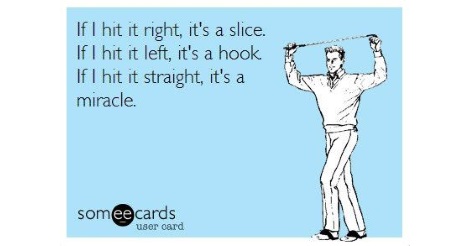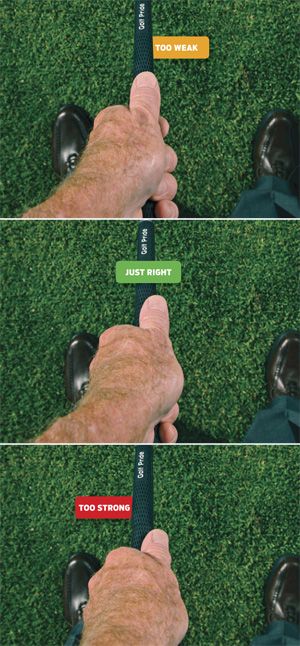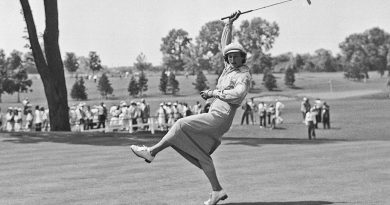Scratch’s Top Tips To Stop Slicing!
Do you suffer from nasty slices? Are you ready go get rid of them and start hitting down the middle just about every time? Getting those drives squared away will greatly improve your score. Unfortunately there isn’t a pill you can take to ease yourself of these aches and pains, but fortunately enough, Tour Golf Blog came up with some great tips to help you aim straighter:

1. Get your club head square: No matter what else you’re doing, one thing is a fact, if you’re slicing, the club head is not square at impact, and it’s causing you to slice the ball. Practice taking 1/2 and 3/4 swings with your driver, concentrating on watching the club head hit the ball with a square face.
2. Get the club on the right path: There are many swing faults that can cause a nasty slice, but the most common reason is an outside to inside swing path. This just means that you’re not bringing the club down to the ball on a path where the club head can naturally square itself. You need to get the club coming from the inside, and it will almost always be a more solid, square contact at impact. To promote this inside swing path, concentrate on keeping your right elbow at your side when you start your down swing. Letting that elbow get away from your side will let the club wander out to that outside path you’re trying to avoid. Try setting a plastic water bottle on the outside of the ball, parallel with your feet. Place it a few inches away from the ball, so a club can contact the ball. This little guide will instantly tell you if you’re coming over the top and hitting the ball on an outside to inside path, because the bottle will go flying. Do this drill until you naturally stop hitting the bottle.
3. You don’t have to kill it: Yeah, we all want to bomb 317 yard drives, but just putting your ball in the fairway should be the main goal, especially if you have a slicing problem. Slow your tempo down and make yourself do a 1-2 count. Count (1) on the way back, and (2) as you start your downswing. All you’re trying to do here is get yourself a rhythm that will stop you from rushing your back and down swing. Trust me…you’ll hit the ball even further with less effort, and you’ll be in the fairway.
4. Get a grip: It doesn’t matter if you use interlocking, overlapping, or 10 finger baseball grip, if you’re grip pressure is too weak or too strong, you’ll have a hard time getting the club face square at impact. I like to use a grip scale of 1-10 and always try to make sure my grip is about a 5-6 on that scale..10 being a strangle hold death grip. Good grip pressure will allow your wrists to properly turn over as you come through the ball, allowing the club face to naturally square, and hit the ball straight. If you’re grip is too weak, the club face will be open and you’ll slice, too strong and you’ll have a tendency to pull hook. Try holding the club more in your fingers than palms and treat it gently.
5. Close your stance: This is more of a band-aid than anything else, but it will help promote getting the club on an inside path. When you’re standing in your normal square stance, move your front foot a few inches closer to the ball. This will keep your lower body from getting ahead of your upper body, which will almost always cause an open club face. This will feel weird, but hit some shots this way to feel the club on the inside path.
Hopefully these tips will help you start each hole with a better off-the-tee launch! And Help you keep the ball in bounds and on the right fairway, safely away from car windshields and other hazards.
But what happens if your ball might be out of bounds? Luckily this caveman found some answers to that too at Golf Digest
Here is what to do, and the rules in a few “potentially” out of bounds scenarios:
Situation 1: You hit a shot toward an adjacent range. The ball might be out-of-bounds, but there are so many other balls in that general area you can’t be certain, and it’s too dangerous to go and search.
Unfortunately, you have to treat it as a lost ball and play another ball as near as possible to the spot from which the original ball was last played. You also must add a one-stroke penalty to your score. Rule 27-1
Situation 2: You hit a bad shot that hooks off the course and hits a house. The owner comes storming out the door, sees your ball in his yard, picks it up and throws it back onto the course.
If a ball in play and at rest is moved by an outside agency, it must be replaced. Rule 18-1 But since your shot went out-of-bounds, take a stroke penalty, and hit from the spot where you had previously played. Rule 27-1
Situation 3: In a stroke-play round, your ball lands in someone’s back yard next to the green. The other lawns near your ball are designated out-of-bounds by white stakes. But the yard where your ball lies isn’t marked.
Finish the hole with two balls, declaring beforehand the one you’d like to count. Play one as if the ball was out-of-bounds; play the other as if it was in-bounds. Ask at the end of the round for a ruling to record your score. Rule 3-3
Situation 4: Your ball is lying in-bounds next to a fence that marks the course’s boundary. You can’t take relief without penalty, and the only way to play the next shot is to stand on the other side and hit the fence.
Whack away. You can stand out-of-bounds to play a shot in-bounds, and it’s OK to move the ball by making a stroke that strikes the out-of-bounds fence directly behind the ball. Decision 14-1/5
Situation 5: You’re playing golf in a new housing development in which the empty lots are marked as out-of-bounds. You slice a shot, and it rolls through an empty lot and comes to rest in another fairway.
Unless there is a local rule in place designating fairways other than the one you’re playing as being out-of-bounds, your ball is in play. There’s no penalty in this case, either. Definitions: Out-of-bounds
Situation 6: Your ball is close to an out-of-bounds marker, but it’s still in play. However, a tree growing outside the boundary of the course has a few hanging branches that will interfere with your swing.
As much as you might like to, you can’t bend or break the branches to make your swing easier. The fact that the tree is out-of-bounds does not change the rule about improving the area of your intended swing. Decision 13-2/19
Check out these videos for more help!
Hope this helps all of my Rock Heads shoot some lower scores! Good Luck!




